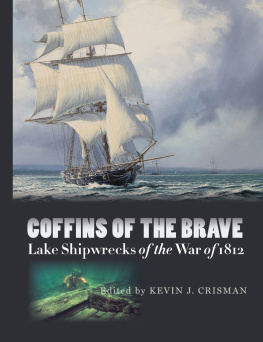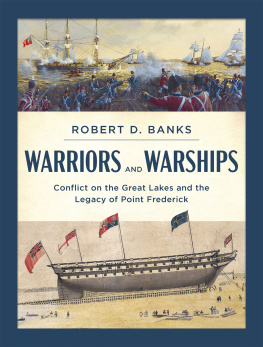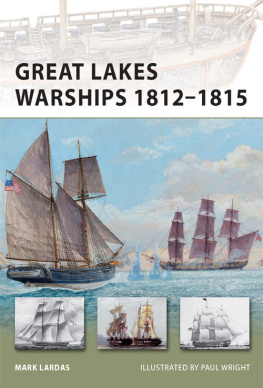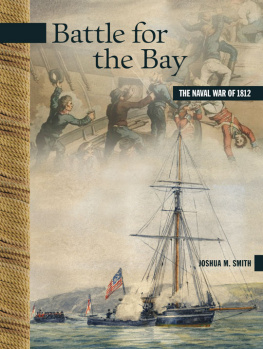Coffins of the Brave

ED RACHAL FOUNDATION
NAUTICAL ARCHAEOLOGY SERIES
in association with the
Institute of Nautical Archaeology
and the Center for Maritime Archaeology
and Conservation
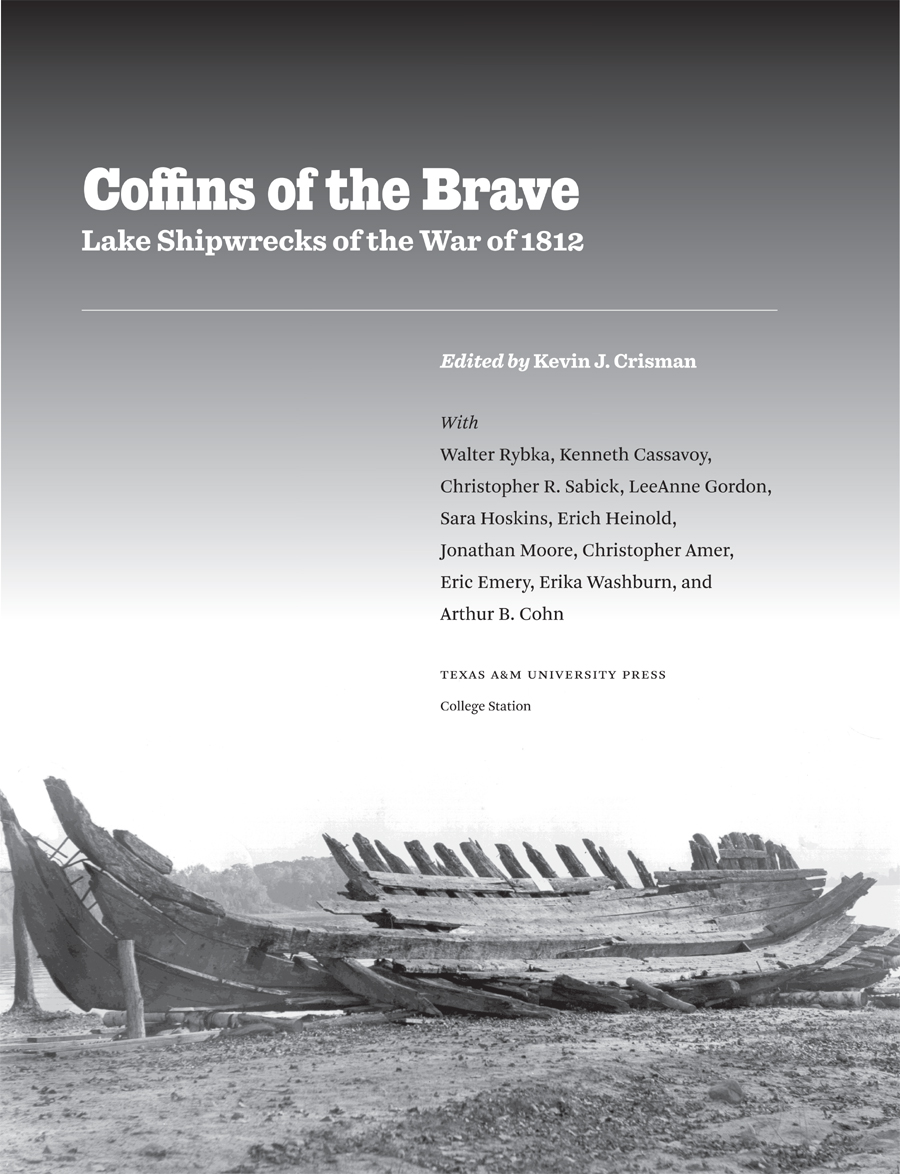
Copyright 2014 by Kevin J. Crisman
Manufactured in the United States of America
All rights reserved
First edition
This paper meets the requirements of ANSI/NISO Z39.48-1992. (Permanence of Paper)
Binding materials have been chosen for durability.

Library of Congress Cataloging-in-Publication Data
Coffins of the brave : lake shipwrecks of the War of 1812 / edited by Kevin J. Crisman ; with Walter Rybka, Kenneth Cassavoy, Christopher R. Sabick, LeeAnne Gordon, Sara Hoskins, Erich Heinold, Jonathan Moore, Christopher Amer, Eric Emery, Erika Washburn, and Arthur B. Cohn.First edition.
pages cm (Ed Rachal Foundation nautical archaeology series in association with the Institute of Nautical Archaeology and the Center for Maritime Archaeology and Conservation) Includes bibliographical references and index.
ISBN 978-1-62349-032-4 (hardcover, printed case : alk. paper)
ISBN 978-1-62349-076-8 (e-book)
1. Naval architectureGreat Lakes (North America)History19th century. 2. ShipwrecksGreat Lakes (North America) 3. Underwater archaeologyGreat Lakes (North America) 4. Great Lakes (North America)Antiquities. 5. United StatesHistoryWar of 1812Naval operations. 6. United States. NavyHistoryWar of 1812. 7. Great Britain. Royal NavyHistoryWar of 1812. I. Crisman, Kevin James, 1959 editor of compilation. II. Series: Ed Rachal Foundation nautical archaeology series.
VM23.7.C65 2014
973.525dc23
2013039502
In memory of
J. RICHARD STEFFY
A quiet genius, a mentor, and a pathfinder for all of us in the field of nautical archaeology
Acknowledgments
Any project that has been in the works as long as this book and that involves archaeological research on so many different shipwrecks is going to accumulate a long list of people and institutions that deserve acknowledgment for their contributions of time, money, and expertise. It is with great pleasure that the editor and authors recognize them in the following pages.
It seems appropriate to recognize the editors home institutions and the press publishing this book first, since they have been there in so many ways from the start. The research on War of 1812 naval shipwrecks in general, and the preparation of this book in particular, have been tirelessly supported by the nonprofit Institute of Nautical Archaeology (INA) and its board of directors and by Texas A&M University (TAMU). Both have sponsored many of the excavation and recording projects described herein. The Nautical Archaeology Faculty Fellowship, a university research chair created by an INA benefactor and administered by TAMU, has contributed greatly to the completion of much field and laboratory work, as well as the preparation of this manuscript. The editor particularly wishes to thank INA founder George F. Bass and INAs current and former directors for their support over the years.
Texas A&M University Press and its staff warmly encouraged the editors proposal to publish this book many years ago, and they have been unbelievably patient waiting for the final manuscript to arrive. In particular the editor would like to recognize former editor-in-chief Noel Parsons, current director Charles Backus, and the Presss own cheerleader and saint-inresidence, editor-in-chief Mary Lenn Dixon.
The editor also wishes to recognize faculty colleagues, staff members, and students in the TAMU Nautical Archaeology Graduate Program and the Department of Anthropology, many of whom have participated in 1812 ship projects, contributed expertise and resources, or have simply been encouraging over the years. A full list of these people is, alas, too long to include here, but special thanks must be tendered to Donny L. Hamilton, whose support and friendship for over thirty years have been consistent and greatly appreciated.
The list of federal, state, provincial, and private institutions managing 1812-era naval wrecks and sites and supporting research described in this book is extensive, and all deserve our thanks for the work they have done over the years to protect our heritage and promote the creation of new knowledge through archaeology. One organization has been extensively involved in this cause on Lake Champlain in particular but on other North American lakes as well: the Lake Champlain Maritime Museum (LCMM) at Basin Harbor, Vermont. The LCMM and its former director (and cofounder) Arthur B. Cohn have consistently taken the lead in promoting the responsible stewardship of our inland maritime heritage. It has been a pleasure to work with the LCMM and its staff over the years.
Other institutions involved in the management, study, or display of the wrecks and sites described in this book include the Pennsylvania Historical and Museum Commission; Erie Maritime Museum (home port of the flagship Niagara); Flagship Niagara League; Ontario Marine Heritage Committee; Southampton [Ontario] Marine Heritage Society; Nancy Island Historic Site, Wasaga Beach Provincial Park; Discovery Harbour, Huronia Historical Parks, Ontario Ministry of Tourism, Culture, and Sport; Royal Ontario Museum; Hamilton and Scourge Foundation, City of Hamilton, Ontario; National Geographic Society; Underwater Archaeology Service, Parks Canada; Sackets Harbor Battlefield State Historic Site, Bureau of Historic Sites, New York State Office of Parks, Recreation, and Historic Preservation; St. Lawrence Islands National Park and Fort Wellington National Historic Site, Parks Canada; Office of the State Archaeologist, New York State Museum, New York State Education Department; Skenes-borough Museum and Historical Society of Whitehall, New York; Vermont Division for Historic Preservation; Underwater Archaeology Branch, Naval History and Heritage Command, United States Navy; and Clinton County [New York] Historical Association.
Contemporary plans, sketches, paintings, and prints of the 1812-era warships on the North American lakes are rare, and detailed, reliable illustrations are even harder to find. While this provides added incentive for archaeological studies, the lack of good images nevertheless often makes it difficult for professionals and the public to visualize the ships and battles. For these reasons we are lucky to have the talented, prolific marine artist Peter Rindlisbacher, formerly of Amherstburg, Ontario and currently residing in Texas, to bring the era alive for us. These days, few books on the 1812 inland naval war are published that do not include one or more of his superb paintings. Peters generosity in providing images for this book is greatly appreciated.
The research for this book was assisted along the way by many fine scholars in the world of naval history and nautical archaeology. Long before many of the authors of this book were born, John R. Stevens of Green-lawn, New York, was investigating War of 1812 ships sunk in the lakes, preparing sketches and descriptions of their hulls, and advocating for their study and protection; his notes and recollections were most helpful to a number of us. Great Lakes naval history lost one of its finest scholars with the passing of Robert Malcomson of St. Catharines, Ontario, in 2009; the many citations of his publications in the chapters of this book are a testimony to the breadth and depth of his lifes work. Other naval and War of 1812 historians contributed to our work over the years: the late W. M. P. Dunne of Hampton Bays, New York, was most generous with his extensive files; Dr. Christopher McKee of Grinnell College in Iowa shared archival materials he collected for his superb book
Next page
